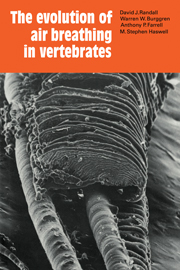Book contents
- Frontmatter
- Contents
- Preface
- 1 Introduction: air breathing in vertebrates
- 2 Gas transfer: the transition from water to air breathing
- 3 Ventilation and perfusion relationships
- 4 Mechanisms of ventilation
- 5 Regulation and control of gas transfer
- 6 The evolution of air breathing: a synthesis and summary
- References
- Index
Preface
Published online by Cambridge University Press: 01 March 2011
- Frontmatter
- Contents
- Preface
- 1 Introduction: air breathing in vertebrates
- 2 Gas transfer: the transition from water to air breathing
- 3 Ventilation and perfusion relationships
- 4 Mechanisms of ventilation
- 5 Regulation and control of gas transfer
- 6 The evolution of air breathing: a synthesis and summary
- References
- Index
Summary
Many physiological studies are interpreted in anthropocentric terms, a tendency reinforced by our more detailed understanding of mammals. This is unfortunate because mammals, with their large size, high metabolic rate, and complete dependence on air breathing are very specialized animals that have invaded only a relatively small section of the total environment. Nevertheless, because of anthropocentric tendencies, studies of the evolution of air breathing in vertebrates have often attempted to trace the process backward from mammals rather than forward in time from aquatic ancestors.
The problem of describing the evolution of air-breathing vertebrates starting with the ancestral aquatic forms is exacerbated by our complete lack of physiological knowledge of these fish. These ancient fish, however, did give rise to modern fish, as well as terrestrial vertebrates, and we can achieve some understanding of these ancestral stocks by studying their aquatic as well as terrestrial descendants.
In this book we decided to try to describe the aquatic ancestral form first and then attempt to delineate the changes that must have taken place during the evolution of air breathing. This was as much a consequence of history as philosophy, as my initial experimental interest was in completely aquatic vertebrates. The results of these earlier studies raised some questions about the types of changes that must have occurred as vertebrates invaded land. We initiated a series of studies on bimodally breathing fish and amphibians in order to answer these questions.
- Type
- Chapter
- Information
- The Evolution of Air Breathing in Vertebrates , pp. vii - viiiPublisher: Cambridge University PressPrint publication year: 1981



